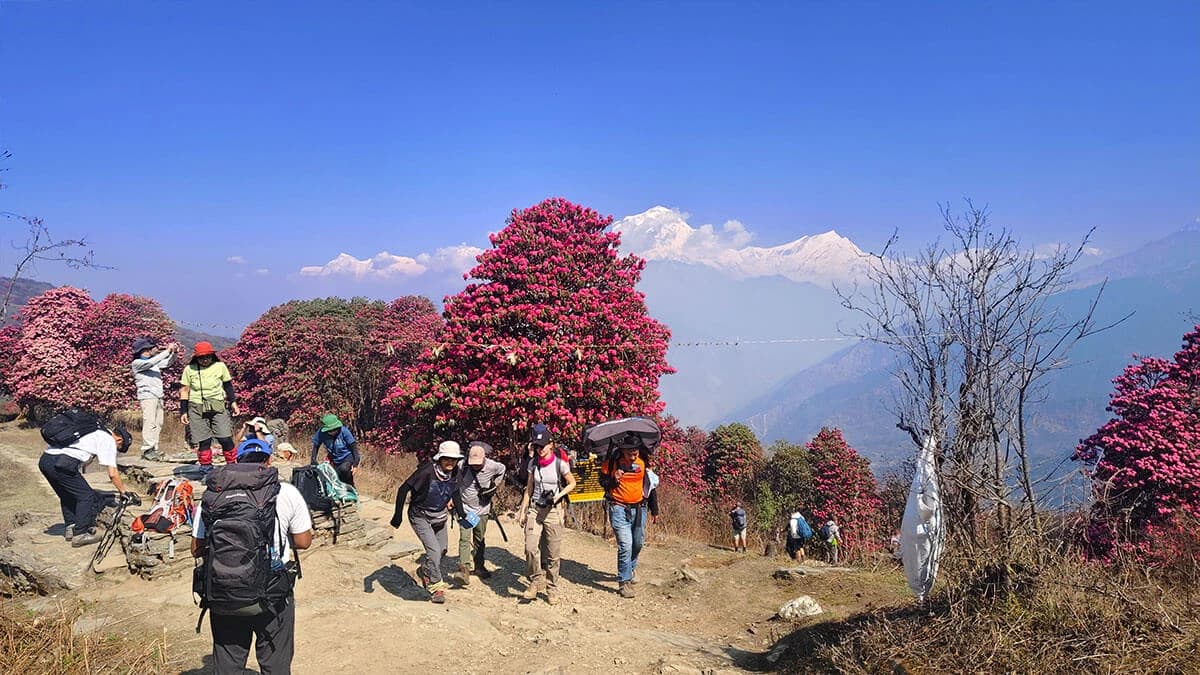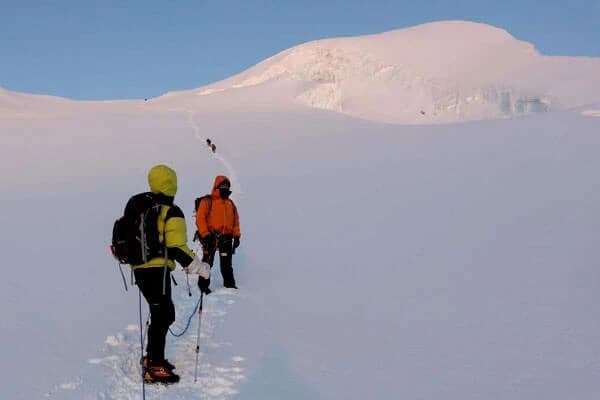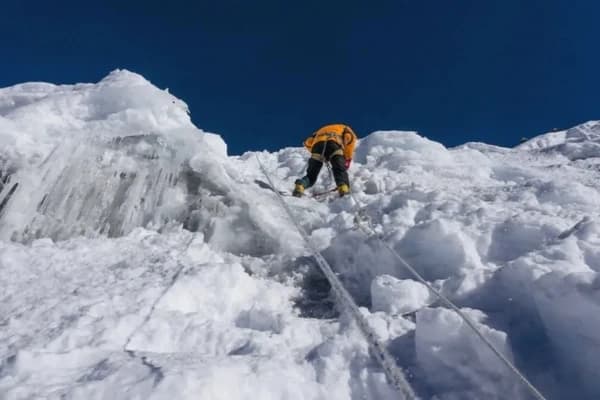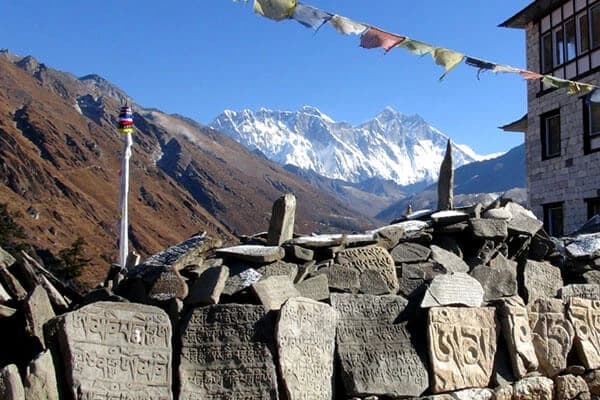If you are a serious mountain lover trekking as you know, for you there is never a bad time for trekking in Nepal you would be trekking every day no matter the elements. However, for most of us mere mortals, some months are much more welcoming than others.
When is the Best Time for Trekking in Nepal?
Nepal’s Trekking Season
Those mighty Himalayas, with their magnetic attraction, significantly influence weather patterns, dictating the days like the Gods they genuinely are. Because of this, forecasts are hard to make when the giant ranges of Everest, Annapurna, and Dhaulagiri have their say. There are, of course, times when you can be pretty certain what the weather will do.
Like most countries in the world, Nepal has four distinct seasons, winter, spring, summer, and autumn, with each of them having its character and offering different options and reasons for choosing that particular time of year to visit.
Spring - From March to May
One popular season for trekking in Nepal is spring. Temperatures are rising from the harsh, cold winter months; the weather pattern is more stable, and like spring around the world, life is beginning to regenerate with all its vigour once more. The most beautiful thing in the world is the world itself, and Nepal in Spring truly reflects this.
It is your best chance to see rhododendrons in full bloom with forests ablaze with colour blanketing the foothills at this time of year. Spring is also a perfect season to spot the most beautiful birds. With milder temperatures in the lower elevation regions (800-2000m), you will enjoy some great days in the mountains.
The early mornings and evenings can be a bit nippy when you need to have a layer or two on, days however are sunny and pleasantly warm. At higher altitudes, as winter fades away and spring pushes in, temperatures in regions of over 4000m have a moderate temperature, providing sunny, clear, and warm trekking conditions with fewer people on the trails, meaning there are more overnight choices when choosing a teahouse or lodge.
Pros for Spring Season Trekking
- Temperatures in the upper hills and lower mountain ranges are comfortable, reaching between 16-23º C
- Pleasantly warm days on and warmer nights.
- Snow that has accumulated over winter melts away by April, and the high mountain passes over 5000m come into play such as Cho La, Larkya La, and Thorung La. All are attainable.
- Clear skies also mean less chance of flight cancellations into the mountain districts such as Lukla.
- Fewer trekkers compared to the autumn season, October and November.
- Spring is also the climbing season in Nepal, which makes this a great time to trek to Everest base camp along with the expeditions.
Cons for Spring Season Trekking
- As summer approaches, trekking can get hot and sweaty at lower altitudes
- Possibilities of afternoon clouds which are quite common (generally nights and mornings are clear) provide good mountain views.
Recommended Treks in Spring Season
- Everest Base Camp Trek
- Annapurna Circuit Trek
- Annapurna Sanctuary Trek
- Ghorepani Poon Hill Trek
- Mardi Himal Trek
- Langtang Valley Trek
- Upper Mustang Trek
- Everest Three Passes Trek
- Gokyo Valley & Chola Pass Trek

Summer - From June to August
Summer is monsoon season and certainly not the best time to visit Nepal if you are planning a trek. Significant heat and moisture rise from the Indian Ocean, bringing hot temperatures, clouds, haze, and rain to Nepal, and views are very limited. The season lasts from June to late August, with many warm and humid days.
The rains are known to wash away bridges, trails become very slippery and public transport becomes unreliable, not to mention the ever-evasive leeches that somehow find a place to drink you even if you have taken what you think to be every precaution.
Lower-elevation hill treks are still possible on the better trails. Remember, it doesn’t rain every day, and when it does, most of the rain falls at night. The drier Mustang and Dolpo regions are exceptions, as both lie in the rain shadow in Nepal. The peak of the Monsoon season occurs in July, from the end of July onwards the rain begins to taper off as the drier autumn period gets closer.
Pros for Summer Treks
There aren’t many we can think of other than if you don’t have any other options when taking a vacation, but there are still some options available. Also, bear in mind that Nepal is still a beautiful place to visit, and if you don’t mind the rain, there are lower-altitude treks (mainly in the Annapurna Region) you could consider. Treks in the rain shadow of Nepal remain unaffected by the monsoon.
Cons for Summer Treks
All of the above reasons are mentioned.
Suggested Treks in the Summer Season
- Lower Dolpo Trek
- Upper Dolpo Trek
- Upper Mustang and Lo Manthang.
- Poon Hill Trek
Autumn - From September to November
Most people vote for Autumn with their legs and feet when asked, “What is the best season to trek in Nepal? The weather is almost perfect, and the views are out of this world. One thing is certain: you certainly won’t be alone on the trail. Temperatures range from 22 to 27 degrees Celsius during the daytime, the nights are cool.
In September, you may still encounter some leftovers from the monsoon season, which can still rain in the afternoons. High Passes can be difficult to cross at times, but you should generally have no problems.
October arrives, the trails are clear, the skies are high, and the magnificence of the Himalayas (whatever trek you choose to do} stand there naked in all their glory. In November, you may encounter occasional snowfall at higher elevations as the temperatures taper off. Another draw for choosing the autumn season is with the monsoon over for another year, the main festivities Nepal is renowned for begin.
These special celebrations only go to add to your overall experience. With almost every trail open at some stage over the season, Nepal becomes Inspiration itself, a true trekker’s paradise. Below are 15 of the more popular trails to consider.

Suggested Autumn Treks
- The Everest Base Camp Trek
- The Annapurna Circuit Trek
- The Annapurna Sanctuary Trek
- The Upper Mustang Trek
- The Gokyo Lake & Renjola Pass Trek
- The Makalu Base Camp Trek
- The Langtang Valley and Goshainkunda Trek
- The Upper Mustang Trek
- The Everest Three Passes Trek
- The Lower Dolpo Trek
- The Upper Dolpo Trek
- The Manaslu Circuit Trek
- The Manaslu and Tsum Valley Trek
- The Nar Phu Trek
- The Kanchenjunga Base Camp Trek
- The Dhaulagiri Circuit Trek
Winter - From December to February
Winter at high altitudes means snow in Nepal. This can, at times, make things challenging, but generally, winter is another great season for trekking. Nepal becomes a fairy tale winter wonderland with charming cosy lodges, warm fires in the evening, and a chance to fully interact with the locals as there are far fewer trekkers on the route.
Trails at lower altitudes are particularly appealing, particularly those in the Annapurna Region. With the freed-up trails, a winter season is a great option for the trekker who wants a more personal Himalayan adventure. The Ghorepani Poon Hill Trek, also known as the Annapurna Sunrise Trek, is one such short trek that is worth considering in the winter.
You will need to wrap up warm at night, but generally, during the day, when the sun is out, temperatures are delightful for trekking.
- The Poon Hill Trek
- Ghorepani and Annapurna Base Camp Trek
- The Annapurna – Siklis Trek
- The Panchase Trek
- Arun Valley and Milke Danda Trek
- The Mardi Himal Trek
- The Everest Panorama Trek
- The Helambu trek
- The Pike Peak Trek
- The Tamang Heritage Trek
So as you can see, it is not easy to choose one particular season as every season has its charm. Even monsoon time can be an advantageous trekking experience on the right trails. We can say that whenever you come, you will be greeted by the tremendous warmth and hospitality Nepal is renowned for.
But please remember, to get the most from your time here, come with an inquisitive mind. “If you reject the food, ignore the customs, fear the religion, and avoid the people, you will miss so much, and you might as well have stayed at home.

So Let’s Go Trek
To begin with, you do not need to bring all the gear from home. It is possible nowadays, with very few exceptions, to kit yourself out completely on arrival in Kathmandu. If you are planning to do this, you will need at least a couple of days to get around before your trek begins.
Buying High-Quality Trekking Gear
If you plan to invest in top-quality equipment that will last a lifetime. Nowadays, it is possible to buy all your gear at many famous brands of shops in Kathmandu. Most of these are situated on a road called Tridevi Sadak, a road that leads to Thamel from Durbar Marg.
- North Face Kathmandu Store – located on Tridevi Sadak, Thamel
- Red Fox Kathmandu – situated in Narayanhiti Path, Lal Durbar Marg
- Sherpa Kathmandu – situated in Narayanhiti Path, Lal Durbar Marg
- Black Yak Kathmandu – situated in Narayanhiti Path, Lal Durbar Marg
- Mountain Hardware Shop Kathmandu is located in Tridevi Sadak.
If you do not want to spend a fortune, it is equally possible to buy cheap trekking gear of decent quality in Kathmandu. A word of warning: you need to check the quality, especially the fabric, zips, and stitching, as the quality varies considerably, yet most similar items offered start at around the same opening price. After that, you need to bargain.
If you have not encountered bargaining before, to get better at it, it is worth visiting several shops to check on the prices, sit down, and practice. The outcome will be a mix of how talented you are as a negotiator and how much you expect or are prepared to pay for a particular item.
What to wear when trekking? Trekking Equipment Packing List.
This will, of course, depend on your choice of season, but it is worth mentioning the obvious: the higher you go, the colder it will be. Here are some ideas to help you.
Sleeping Bag
A sleeping bag is not necessary on the more popular treks at low altitudes as lodges and tea houses provide bedding, even at higher altitudes on the popular trails. However, an inner sheet is a good idea as you are not staying in a five-star hotel where bedding is changed daily. A good sleeping bag is a must on the more remote treks where tea house standards are a lot more essential. Check the maximum altitude you plan to reach on your chosen trek, consider the time of year, and then talk to the experts.
T-Shirt
T-shirts should be lightweight and, above all, breathable. You should avoid cotton t-shirts as they absorb moisture from the skin and can make trekking quite uncomfortable. Synthetic fabrics are a good option as they remove moisture from your body.
Fleece Jacket
A lightweight casual jacket made of polyester synthetic wool, such as polar fleece, is also a good example. These provide good warmth and double up as a second layer above your base layer.
Lightweight down jacket
Down jackets nowadays are incredibly light compared to the heavyweights of the past, and they can be easily packed. These provide extra warmth for cold and windy afternoons and evenings. You should consider buying one with a hood.
Waterproof Jacket
You may encounter rain while trekking in Nepal, and whilst generally, you are unlikely to see much during October to March, the best approach is “better to be safe than sorry”. It can get windy in the evenings at high altitudes, and sometimes it rains or snows. Choose a waterproof jacket that should be breathable and preferably has a hood.
Thermal Tops/Bottoms
In cold temperatures, thermal tops and bottoms will help keep your body warm at night.
Sports Bras
A good quality sports bra/s is recommended for women trekkers. Choose a good-quality, well-designed sports bra that will wick moisture away from your skin. It will make you comfortable throughout the trekking journey.
Long sleeve shirts
Long-sleeved shirts will protect you from sunburn and scratches from plants and rocks. In hot weather, t-shirts or shirts are recommended. In cold weather, this can be a perfect base layer.
Footwear
Trekking Boots
The mantra goes to ensure they are comfortable, and it is much better if you have “broken them in” beforehand. Your trekking boots are everything, they should be lightweight with good ankle support with deep lug rubber soles. Remember, it is crucial that your boots fit correctly with thick wool socks. Full leather boots are not recommended.
Trekking Socks
If you are trekking at a high altitude, especially in the winter, you will need a couple of thermal socks. These socks are warm and comfortable and certainly help to prevent blisters. Lightweight socks are fine if you are trekking in summer, especially at lower altitudes.
Gaiters
Gaiters are made of waterproof material. In winter and spring, they provide extra insulation for your lower legs. They are essential for keeping your socks and feet dry during the rainy season.
Camp Shoes/Sandals
On reaching your overnight base, a pair of light camp shoes is much more relaxing than your trek boots while staying at teahouses at the end of the day.
Other Accessories to consider
- Swiss Army Knife. Perhaps the world’s best discovery!
- Most of you will be using a Mobile but don’t forget to take a charger. On the more popular trails, Teahouse will charge a fee for charging.
- Pens and a small Diary, are always useful for jotting down your thoughts or filling in your days..
- Bag locks are important for safety. (2 or more)
- Waterproof Stuff bag/s for storing important items that need to be kept dry.
- Extra spectacles (if you use them) with a cover, you don’t want to be rescued from a far-off valley somewhere!
- Torchlight or Flashlight is essential.
- Small scissors are always useful.
- A wristwatch is a backup to your mobile as it is a lot easier to check the time on the route.
- Power bank – Extremely useful in case electricity is scarce.
- Hand Sanitizer – Recommended.
- Sunglasses – Certainly recommended at high altitudes and essential to prevent snow blindness if you are trekking in snow.
- Multi-Plug – Recommended for remote areas
- A small water bottle, say 500 ml is a must.
- Cigarette Lighter and a few candles.
- Plastic Bags / Plastic Zip Lock Bags.
- Twist-ties, safety pins.
- A novel or two for the evenings.
We hope this helps you plan your trip, for just perhaps travel is the only thing you buy that makes you richer. Nepal Gateway Trekking and Travel will do everything we can to make your journey here a very special and memorable one.




